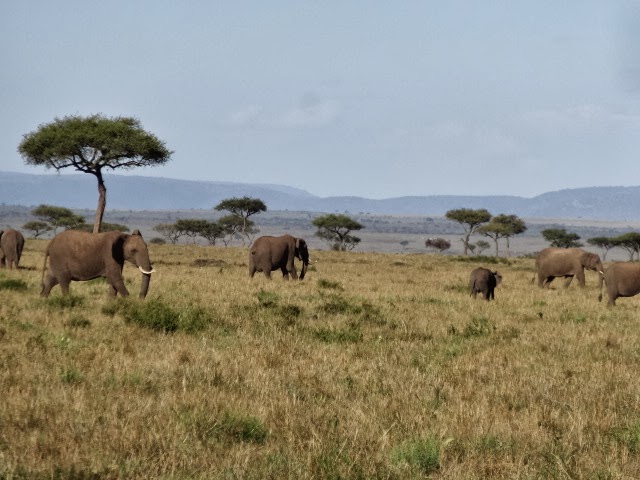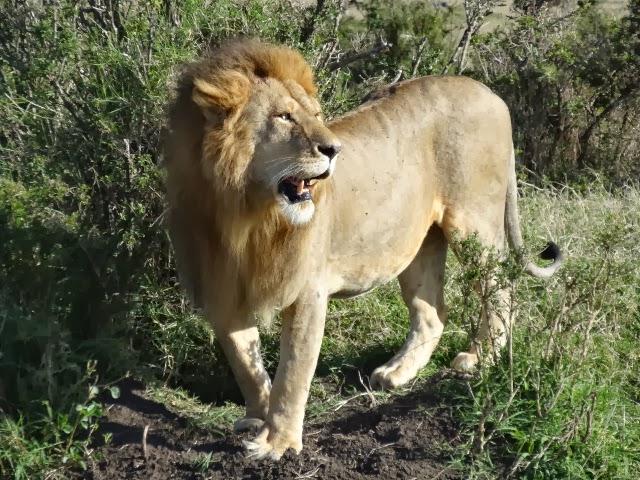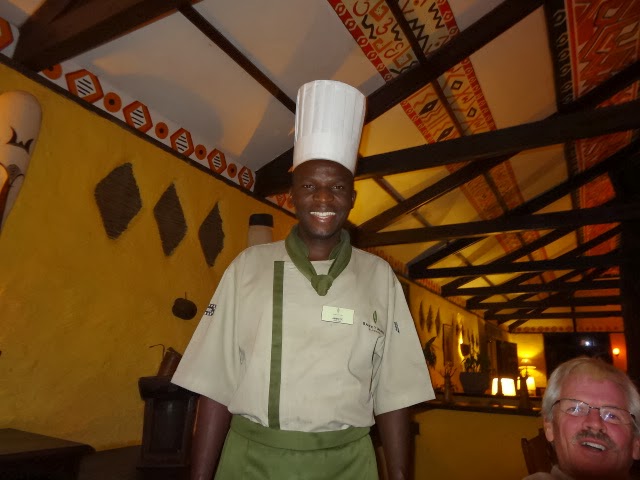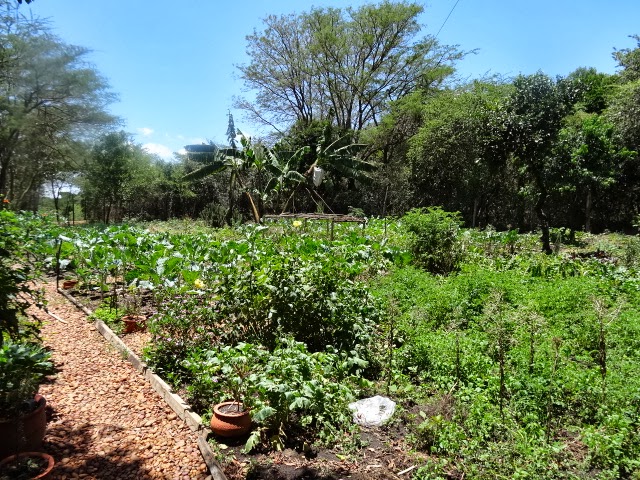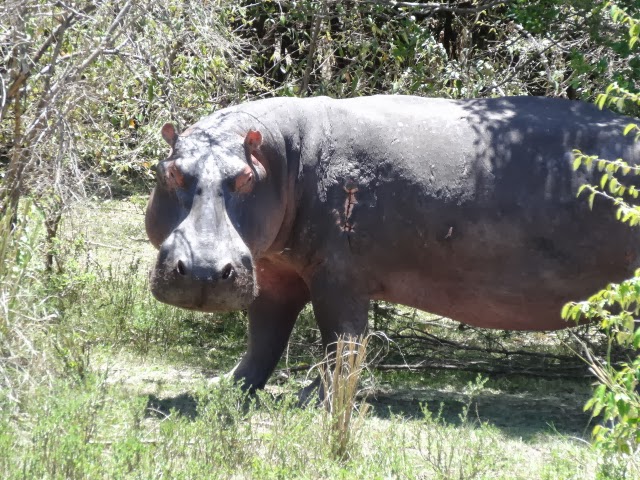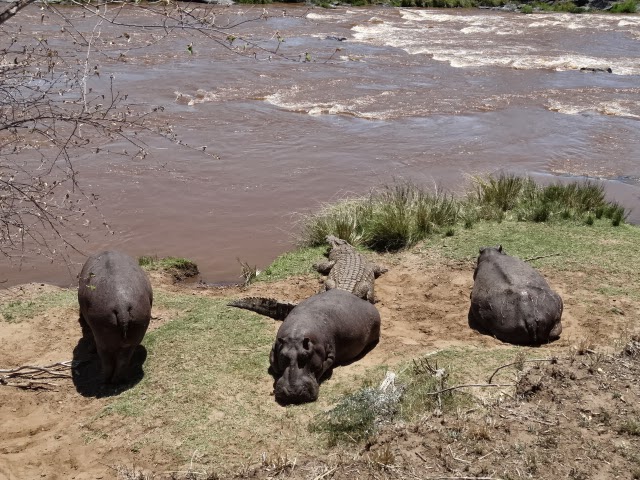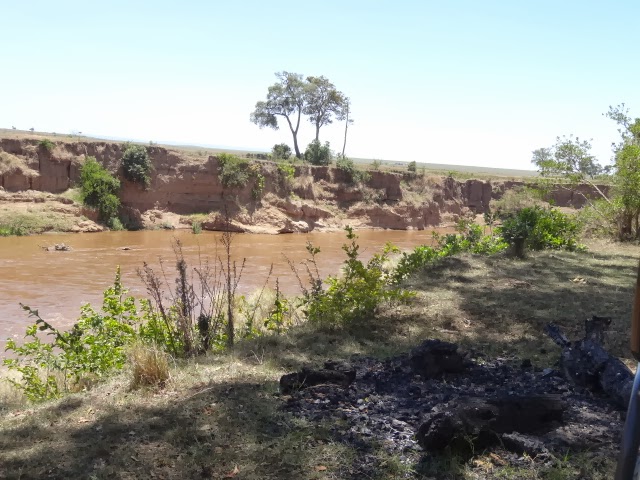 |
| It was difficult to fathom the massive size of this older male elephant we encountered as we began the drive to Tanzania |
 |
| Later, we came across this mom and baby, the smallest of the baby elephants we’d seen in any of the prior days. |
 |
| The drive to Tanzania offered stunning scenery with low lying clouds. |
 |
| Hanging partway out the window of the sturdy Toyota Land Cruiser, I took this shot as Anderson made our way over terrain definitely not suited for road vehicles. |
 |
| Gradually, the scenery began to change to include the migrating wildebeest, many of whom had yet to make the journey back to the Serengeti. Anderson explained they will continue on, instinctively finding their way to the large herds of millions. |
 |
| Unable to get as close as we’d like due to the rough terrain we did our best to zoom to get the following photos on the remaining wildebeests.
|
 |
| The closer we were to the Kenya/Tanzania border, everything changed; the temperature became hotter, more humid with fewer breezes, the flies clustered around us, the dust blew in our faces and eyes and the landscape became more sparse and unfriendly. |
 |
| The wildebeest grazed for the few remaining green patches of vegetation, soon to realize that they must move on to meet up with their herds. |
 |
| Increasing in numbers as we approached the border. |
 |
| Although the sight of the two-plus million wildebeest would have been unbelievable, I began to wonder if doing so was as important to me as it had been in the past. It may sound as if its a rationalization for not having been able to see it but, the flies were a huge deterrent for both of us. They were flying into our noses, mouths, and ears. It was awful. |
 |
| Finally, we were able to stand at the marker that separates Kenya from Tanzania, a pose worthy opportunity for all of us. |
 |
| Wildebeests, not quite as homely as warthogs held less appeal for us. Warthogs are playful and funny. Wildebeests, not so much. |
Several years ago, as Tom and I were seated on the comfy bar stools at the island in our kitchen in Minnesota, we watched a National geographic episode with a stunning video of the Great Migration.
 |
| Yeah, I know I looked goofy with my Bugs Away hat, a scarf tied on my face. Honestly, I didn’t care. If I’d had a paper bag on hand, I’d have worn that. We did everything we could to keep the flies out of our noses, mouths, and ears. |
As we watched the two-plus million wildebeest and other migratory animals as they traveled from the Serengeti in Tanzania, crossing the winding Mara River several times, to end for the lush vegetation during the rainy season in the Masai Mara in Kenya, it proved to be a profound experience for me with my lifelong dreams of Africa.
(To see the map of Diani Beach to the Masai Mara Kenya and Tanzania, please click here).
As the show ended, I looked in Tom’s eyes and said, “I must see this in my lifetime.” He smiled and said, “Yeah sure, Sweetie.”
 |
| Tom, Anderson, and me, posing at the Kenya/Tanzania border marker, still smiling but not objecting when it was time to head back to the Masai Mara. |
At this point, we had yet to conceive of the idea of traveling the world, not even as a distant thought, never as words spoken to one another. In January 2012, as Tom’s retirement was fast approaching in 11 months, in a single day, in a single conversation, we made the decision.
 |
| Our outstanding guide and new friend, Anderson. His exuded pure joy at our delight and enthusiasm to see what he sees every day, never taking it for granted, which surprised us. |
The next day, the wheels were in motion to begin to contemplate the process of liquidating everything we owned: house, cars, furnishings, clothing, winter coats, stuff, stuff, and more stuff, a lifetime of stuff.
 |
| The small herds of wildebeest continued as we worked our back on yet another long rough road back to the Masai Mara. |
Night after night when Tom returned home, we sorted out the details as to how this would all transpire. During the daylight hours, I set the plan in motion. To say I worked on my computer for 8 to 10 hours a day was an understatement; searching, researching, finding, booking, committing. Relentlessly.
 |
| No more than a few minutes into the return drive, we spotted another mom and baby elephant, tails swishing batting off the flies. They, too, must feel the effects of the dung of millions of animals. |
There were two things we knew for sure:
1. Tom wanted to sail by ship through the Panama Canal: Done on January 13, 2013.
2. I wanted to see the Great Migration: Not completely done. But, completely satisfied for now having been on safari this past week and for having the opportunity to see the tail end of the Great Migration when Anderson drove the six of us to the border of Tanzania to witness the stragglers.
 |
| Although we were quite a distance from them, we enjoyed this photo of mom and bay making their way up a steep incline. |
Cindy and David, a lovely couple, safari mates, had just returned from the full experience. We’d missed it by a week or more. Anxious to hear their reaction, I pumped them for details. Was I jealous? Not at all. was excited to glean whatever tidbits they’d share of their glorious experience. And they did.
 |
| After about an hour into the return drive, we saw the last of the wildebeest stragglers, facing a long walk home to the Serengeti in Tanzania. (80% of the Serengeti is in Tanzania with the remaining 20% in Kenya). |
Oddly, they were not disappointed to see a portion of it again when Anderson promised to take us to see the tail end of the Migration on the third day of our safari.
 |
| As the landscape became less cluttered and the flies no longer nipped at us, we were happy to be returning to the Masai Mara. |
We’d already found the rhinos Cindy and David longed to see earlier that morning, that we had already seen and photographed the previous day when they weren’t with us. Once they had their photos, having also completed their Big 5, they gladly joined us, a feeling we well understood and appreciated.
 |
| And then, there were elephants lumbering across the road only feet from our vehicle. |
The border of Kenya and Tanzania was an extraordinarily rough hour and a half drive from our location at the time in the Masai Mara. No words can describe how rough. The dirt and rock trail was a far cry from a road. As the crow flies it may have been a half-hour drive. Anderson masterfully maneuvered the Land Cruiser through rock creek beds, water-filled creeks, up steep inclines, and down treacherous rocky hills.
In my old life, you couldn’t have paid me to ride along on such a road. Here I was, that sh_ _ eating grin on my face, bouncing along with the rest of us, occasionally holding Tom’s hand out of pure delight, with the unfathomable knowledge that we were on our way to another country, albeit only the border, having the times of our lives. Besides, we had the dangerous road in Belize and the more frightening road in Tuscany behind us. We were now seasoned “road warriors.”
The closer we got to Tanzania, the flies were unbelievable. Imagine the dung of over two-plus million animals as they made their way across the same terrain we were traveling. The flies. OMG!
 |
| The “Retired Generals” lined up to welcome us back to the Masai Mara. |
As they attempted to fly into our mouths, our eyes, our nostrils, our ears, I tied my BugsAway hat’s hanging fabric around my face, hoping to offer some protection. For whatever reasons mosquitoes love me, flies love me more. Remember the flies in Tuscany? This was 1000 times worse! I wrapped my hands into the parka I’d worn that morning leaving no exposed skin, except for what remained of my face which you can see in the included photos.
Suddenly, something hit me. Ah, maybe it was OK we didn’t see the Great Migration in its entirety. With the mind-blowing safari experience these past days, my desire to be in the bush was richly fulfilled, although not ended. Someday, we’ll go back.
In the end, the flies may deter us from seeing the Great Migration after all. I feel no disappointment or loss. Seeing the remaining wildebeest as we neared Tanzania was enriching. Leaving Tanzania to return to the fly-free Maasai Mara was equally enriching. GET ME OUT OF HERE! I didn’t say it, not wanting to be a wimp, but I sure thought it.
 |
| The Masai gathered up their cows to return them to the security of the village, close to our camp, away from the risk attack. |
By the time we headed back on an alternative equally rough dirt and rock road it was already 2:00 in the afternoon when we pulled into Camp Olonana. Having had breakfast the second day in the bush, I was hardly hungry for lunch, knowing we’d be having dinner after our later game drive, which we pushed to 4:30 pm instead of the usual 4:00 pm. After being in the vehicle for 7 1/2 hours, we all welcomed a little break.
We were covered with dust and dirt. We didn’t care. There was no sense in cleaning up to go out on safari again in a few hours. By the time we returned from the 4:30 drive at 7:00 pm, we were exhausted and hungry, ready for dinner.
 |
| The giraffes walked along the hillside at our camp as we wearily sauntered to the restaurant at Camp Olonana for late lunch, cold beverages, and time to regroup for the upcoming afternoon drive. |
We made a quick stop at our tent to pick up our laptops to post photos and to brush our teeth to get the dirt and dust out of our mouths. For either of us not to shower and change to have dinner in a restaurant was beyond us. Somehow, we didn’t care.
Another fine safari day ended. The next day, we’d return to Diani Beach on yet a tinier plane at 1:30 pm, after our visit to the Masai Village for our tour with Chief Richard. We’ll share that story in a few days with many photos and surprising facts about these interesting tribespeople, living a sparse and primitive life, far removed from our own reality, to become deeply entrenched in our hearts.
But, Tom and I have decided on one extra post we’ll be presenting tomorrow that we’d intended to include with today’s post. However, after careful consideration for not only our young grandchildren and others who are enjoying looking at the animal photos, we’ve decided to present the “Romantic Lion Couple Mating Ritual.” (How did we get so lucky to observe this event?) with a warning that there are graphic mating photos to be posted tomorrow, October 15th. We’re placing a reminder in the heading should you decide to observe it.
.
Note: A small number of our readers post comments at the end of any particular post. You can return to the prior day’s post to read them once I’ve replied, seeing both the reader’s comment and our reply. We respond in each case within 12 hours or less, except on travel days which may require longer.
We appreciate the comments as an opportunity to stay in touch “with the world” but also as an opportunity to respond to questions on the information we may have missed in posting. Feel free to check the prior day’s comment daily (some days, there aren’t any, other days there are several), perhaps inspiring you to comment as well. We don’t care if you misspell or make typos. Good grief, I make my share of typos, writing almost every day!














































